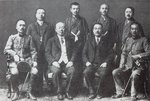Kenji Doihara
| Surname | Doihara |
| Given Name | Kenji |
| Born | 8 Aug 1883 |
| Died | 23 Dec 1948 |
| Country | Japan |
| Category | Military-Ground |
| Gender | Male |
Contributor: C. Peter Chen
ww2dbaseKenji Doihara was born in Okayama, Okayama Prefecture, Japan. In 1904, he graduated from the Japanese Army Academy. In 1912, he completed his studies at the Army Staff College, upon which he was sent to Beijing, China as a military attaché, where he had learned how to speak Mandarin Chinese along with several other dialects. Between 1921 and 1922, he served briefly in eastern Russia during the Siberian Intervention, but for the most part since the late 1910s, he had been working for Japanese Army military intelligence. Between 1926 and 1927, he was attached to the 2nd Infantry Regiment, and in 1927 the 3rd Infantry Regiment. In 1927, he was a part of an official tour to China. Between 1927 and 1928, he was attached to the 1st Division. Between 1928 and 1929, he was a military advisor to the Chinese government. In 1930, he was promoted to the rank of colonel and became the commanding officer of the 30th Infantry Regiment. Between 1930 and 1931, he was assigned to the Army General Staff to head military espionage operations from the Tianjin office in China. In 1932, he was transferred to the Mukden, China office as head of the Houten Special Agency. While in the northeastern region of China known as Manchuria, he was jointly responsible, with Colonel Seishiro Itagaki, for engineering the Mukden Incident that ultimately led to the Japanese invasion and occupation of the region. In this role, he also exfiltrated former Emperor of China Puyi to Manchuria to serve as the head of a puppet nation, and he successfully bribed several Chinese officials and military officers to further the Japanese cause. Between 1932 and 1933, at the rank of major general, he was the commanding officer of the 9th Infantry Brigade of the Japanese 5th Division. Between 1933 and 1934, he was again the head of the Houten Special Agency. Between 1935 and 1936, he was attached to the 12th Division. Between 1936 and 1937, he was the commanding officer of the 1st Depot Division in Japan. In 1937, after the start of the Second Sino-Japanese War, Doihara was given command of the 14th Division in northern China; in this role he was involved in the Battle of Lanfeng in May 1938. Between 1938 and 1939, he was attached to the General Staff as the head of the Doihara Special Agency. In 1939, he became the commanding officer of the Fifth Army of the Japanese Kwantung Army in Manchukuo. In 1940, he became a member of the Supreme War Council, the head of the Army Aeronautical Department of the War Ministry, and the Inspector General of Army Aviation. Between 1940 and 1941, he was the Commandant of the Japanese Army Academy. On 4 Nov 1941, General Doihara voted to agree with the attack on the American naval base at Pearl Harbor. In 1943, he was made commander-in-chief of the Eastern Army District. In 1944, he was appointed the governor of Johor State in Malaya as well as the commander-in-chief of the Japanese Seventh Area Army based in Singapore. In 1945, he returned to Japan and became the Inspector General of Military Training, a senior position in the Japanese Army while also serving as the commanding officer of the Twelfth Area Army. Immediately before the end of the war, he was the commander of the 1st General Army. After the war, he was arrested and tried before the International Military Tribunal of the Far East in Tokyo. He was found guilty on 8 counts of war crimes and was sentenced to death. He was executed by hanging in late 1948 at Sugamo Prison in Tokyo, Japan.
ww2dbaseDoihara's exploits in northeastern China earned him the nickname "Lawrence of Manchuria".
ww2dbaseSource: Wikipedia.
Last Major Revision: Oct 2010
Kenji Doihara Interactive Map
Photographs
 |  |
Kenji Doihara Timeline
| 8 Aug 1883 | Kenji Doihara was born in Okayama Prefecture, Japan. |
| 21 Sep 1931 | The Japanese installed Colonel Kenji Doihara as the mayor of Mukden, Liaoning Province, China. |
| 23 Dec 1948 | Kenji Doihara was executed at the Sugamo Prison in Tokyo, Japan. |
Please consider supporting us on Patreon. Even $1 per month will go a long way! Thank you. Please help us spread the word: Stay updated with WW2DB: |

» Mukden Incident
» Battle of Harbin and Establishment of Manchukuo
» Henan Campaign
» Tokyo Trial and Other Trials Against Japan
- » 1,182 biographies
- » 337 events
- » 45,119 timeline entries
- » 1,248 ships
- » 350 aircraft models
- » 207 vehicle models
- » 376 weapon models
- » 123 historical documents
- » 261 facilities
- » 470 book reviews
- » 28,411 photos
- » 365 maps
Winston Churchill, on the RAF